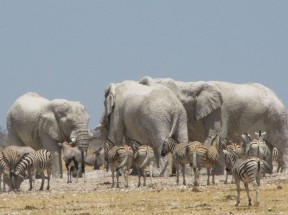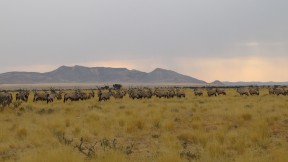Namibia : people and… fish ?

Namibia, one country ? Namibian landscapes range from ocean shores to woodland savannas, from lush floodplains to picturesque deserts.
Species? Well, there are species for everyone’s taste, from marine creatures (Southern right whales, sea lions, variety of fish…) to the “Big Four” (lions, rhinos, elephants, leopards…).
People? A good variety here as well! 2 million people spread over 824,292 square kilometres (well, not really as about one million lives in the northern territories), speaking 26 different languages and originating from 14 native groups.
Helge Denker, who welcomed us at the WWF office in Windoek on our first day explains: when Namibia wasn’t yet an independent state, things were not looking too good for wildlife conservation (but how could that have been otherwise as the apartheid was already putting so much pressure on people): wildlife populations plummeting, extensive poaching and a severe drought were no good signs at all. However, in the mid 1980s this situation began to reverse as a Namibian organization (IRDNC) started building a communal conservation programme. What this means is that since then Namibian communities have been officially acknowledged the right to manage natural resources and wildlife in specific sites. To date, that involves more than 52 community-based sites spread over 121,000 km2. WWF continues to work with partners to increase the amount of land managed by these so-called “conservancies” and to increase the role of women in their management. That seems to promise a future that includes healthy wildlife populations and sustainable economic growth for local people.
To catch you by surprise we will not speak about the long-headed, fierce-horn, lazy-fur, large-ears animals we encountered in the notorious Etosha National Park. Instead we’ll head west on the Atlantic coast and stop for a while in Walvis Bay, a sacred site for ornithologists and a former whaler’s paradise. Accompanied by Nicola, Fisheries officer working for WWF-South Africa, we learned about the history of this fishing town, how prosperous the area is thanks to cold currents coming from the far South, leveraging a huge national fishing industry. Nicola is here to train fishers to implement an Ecosystem Approach to Fisheries Management. Pardon me? Well, you’ll find it all very well explained on their website. But basically what that means is that you can only protect what you understand: so this training aimed at fishers, fisheries staff and managers helps those in close contact with the sea and fishing to understand fish population dynamics, the rational behind the regulations and management measures in place, how to use more selective gears in order not to catch unwanted species such as seabirds, etc. Basically it’s about how to fish smarter for the greater good.
See our gallery of our Namibia trip
